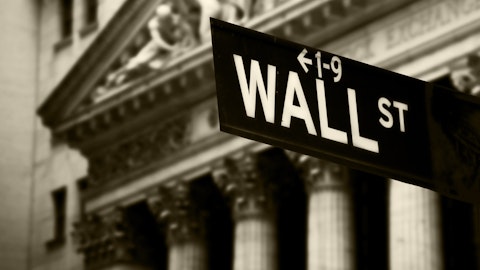In total, Exxon Mobil Corporation (NYSE:XOM) generated $0.67 in earnings-per-share in its most recent quarter versus $0.73 in dividends.
Normally, a payout ratio over 100% would be cause for alarm. That’s not the case with ExxonMobil.
ExxonMobil’s management is committed to paying rising dividends, as evidenced by its 33 year streak of consecutive dividend increases.
In addition, 2 out of ExxonMobil’s 3 segments (downstream and chemical) are generating significant cash flows.
ExxonMobil has $3.7 billion in cash on its balance sheet and $38.7 billion in debt. The company’s balance sheet is in excellent shape. ExxonMobil is 1 of only 3 United States corporations with an AAA rating from S&P. The other 2 are Microsoft Corporation (NASDAQ:MSFT) and Johnson & Johnson (NYSE:JNJ). An AAA rating is higher than the United States government’s rating – and the government has the power of taxation on its side. S&P has put ExxonMobil on a 90 day watch; the company may lose its perfect credit rating, but would still have an excellent credit rating nonetheless. This means ExxonMobil will have no difficulty tapping credit markets if it needs additional liquidity while oil prices remain low.
ExxonMobil’s combination of the following factors make it extremely likely the company will continue to pay rising dividends through the current low oil price environment:
– A management willing to pay rising dividends
– Profitable operations that are nearly funding the dividend today despite extremely low oil prices
– Excellent credit ratings
Shareholders of ExxonMobil should not worry about a potential dividend cut – with that said, dividend increases will likely be very small (in the 1% to 3% range per year) while oil prices remain low.
During the third quarter of 2015, the number of funds bullish on ExxonMobil (among those tracked by Insider Monkey) went down to 61 from 67, while the aggregate value of their holdings was equal to 1%. In addition, billionaire Ken Fisher’s Fisher Asset Management reported holding 5.39 million shares of ExxonMobil in its 13F for the fourth quarter of 2015.
Royal Dutch Shell plc (ADR) (NYSE:RDS.B)
Royal Dutch Shell has ‘A’ and ‘B’ class shares. The ‘A’ class shares’ dividend payments are subject to Dutch tax withholdings of 15% in most cases. The ‘B’ class shares are subject to United Kingdom tax laws and do not have a dividend withholding tax. Unless you feel obligated in some way to support the Dutch government, the B class shares are preferred for most United States investors.
Royal Dutch Shell plc (ADR) (NYSE:RDS.B) was created in 1904 when Royal Dutch Petroleum merged with Shell Transport in a move to compete with Standard Oil. Today, Royal Dutch Shell is one of the largest oil coronations in the world with over 90,000 employees spread across 70 countries.
The company reported earnings-per-share of $0.29 in its most recent quarter. Royal Dutch Shell paid $0.47 per share in dividends in the quarter. On the surface, this looks troubling. When one drills down deeper the company’s dividend appears safe.
That’s because Royal Dutch Shell generated $5.4 billion in cash flow from operations in its most recent quarter – and paid dividends of $3 billion. Cash flow from operations are easily covering the company’s dividend. As oil prices have fallen, Royal Dutch Shell has reduced its investing expenditures.

Source: Shell Q4 Earnings Presentation, slide 20
Notice in the picture above management’s intention to pay steady or rising dividends in 2016. This is a positive sign from management that the company’s dividend is important to them.
Royal Dutch Shell plc (ADR) (NYSE:RDS.B) is focusing on streamlining operations and divesting unnecessary projects. The image below shows how many projects the company has recently cancelled or divested to conserve capital.

Source: Shell Q4 Earnings Presentation, slide 9
While Shell has been postponing and divesting many of its projects, the company is planning a ~$70 billion acquisition of British Gas. Royal Dutch Shell is attempting to take advantage of the decline in oil and gas equity valuations through this large acquisition. The acquisition will be funded with a mix of cash and stock. The British Gas acquisition will result in significant savings through synergies. Royal Dutch Shell plans to divest ~$30 billion in assets from 2016 through 2019, after the acquisition is complete.
Royal Dutch Shell’s cash flows remain strong, despite low oil prices. The company’s cost cutting efforts and commitment to its dividend make it very likely the company will continue to pay steady or rising dividends through the current low oil price environment.
A total of 34 funds from the Insider Monkey database reported holding shares of Royal Dutch Shell in the previous round of 13F filings, having amassed less than 1% of the company’s outstanding stock.





